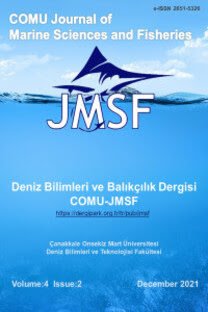Çanakkale Kıyılarında Farklı Yapım Materyallerinin Yemli Balık Tuzakların Av Verimine Etkisi
Bu çalışma, yemli tuzaklarda kullanılan farklı
materyallerin av verimine etkisini ölçmek amacıyla Kasım 2013 – Kasım 2014
tarihleri arasında yürütülmüştür. Çalışmada üç farklı tuzak tipinde ve iki
farklı tünel tipine sahip toplam 12 adet tuzak, tel ve ip ağ ile donatılarak hazırlanmıştır.
Çanakkale ve Gelibolu Yarımadası kıyılarında toplam 72 av operasyonu
gerçekleştirilmiştir. Denemelerde 18 familyaya ait 34 türden toplam 1604 adet
ve 132,4 kg birey yakalanmıştır.
Kullanılan materyal açısından, tel ağ kullanılan tuzakların av veriminin
ip ağ kullanılanlardan daha yüksek olduğu görülmüştür ancak birey sayısı ve
ağırlık bazında istatistiksel olarak aralarında önemli fark bulunamamıştır (p>0,05). Aynı modele sahip tuzakların
kendi aralarında yapılan materyal karşılaştırmalarında, yakaladıkları ürün
adedi olarak aralarındaki fark önemsiz bulunmuştur (p>0.05). Ancak “O” şekilli tuzak modeli tarafından
yakalanan ürünün ağırlık bazında miktarları arasındaki fark istatistiksel
olarak önemli bulunmuştur. (p<0.05). Av verimi açısından önemli farklılık
olmamasına rağmen kullanım kolaylığı ve dayanıklılık açısından ip ağ materyalin
kullanımının daha uygun olacağı sonucuna varılmıştır.
Anahtar Kelimeler:
Yemli tuzaklar, av verimi, ip ağ, civciv teli, Çanakkale
The Effect of Different Construction Materials on the Catching Efficiency of Baited Fish Traps in Çanakkale Coast
This study was conducted between November 2013 and November 2014 to determine the effects of different materials used on baited traps on fishing efficiency. In the study, three different types of traps with two different types of funnel, which were totally 12 traps, were prepared by covering wire mesh or multifilament net. Seventy-two fishing operation were performed in the coasts of Çanakkale and Gallipoli Peninsula. A total of 132.4 kg of catch, which belonged to 34 species in 18 families, were obtained during trials. According to the material used, the traps covered with wire mesh were seen more efficient than traps covered with rope net. However, there was no statistically significant difference among the aspects of number and weight of fishing (p>0.05). In the comparison of materials between the traps with the same model, the difference between the number of products was found to be insignificant (P>0.05). However, the difference between the weights of the product captured by the “O” shaped trap model was statistically significant (p<0.05). Although there is no significant difference in terms of fishing efficiency (p>0.05), it was concluded that the use of the multifilament net material in terms of ease of use and durability would be more appropriate.
Keywords:
Baited Traps, catching efficiency, multifilament net, wire net, Çanakkale,
___
- Ayaz A., Özekinci U., Altınağac U., & Özen Ö. (2006). Üstten girişli yuvarlak tel sepetlerin hayalet avcılık açisindan incelenmesi. E.Ü. Su ÜrünleriDergisi, 23 (1/3): 351-354.
- Ayaz, A., İşmen, A., Özekinci, U., Altınağaç, U., Özen, Ö., Yığın, Ç.C., Cengiz, Ö., Ayyıldız, H., & Öztekin, A. (2010). Kuzey Ege’ de dip uzatma ağlarının seçiciliği ve hedef dışı av oranlarının belirlenmesi üzerine araştırmalar. TÜBİTAK 106Y021 nolu proje, Ankara.
- Çekiç M., Dal T., Başusta N., & Gökçe M.A. (2005). Comparison of two different types of basket trap on fish catches in İskenderun Bay. Turkish Journal of Veterinary and Animal Science, 29: 743-749.
- Ferry R.E., & Kohler C.C. (1987). Effects of trap fishing on fish populations inhabiting a fringing coral reef. North American Journal of Fisheries Management, 7: 580-588.
- Garrison V.H., Rogers C.S., & Beets J. (1998). Of reef fishes, overfishing and in situ observations of fish traps in St John, U.S. Virgin Islands. Revista de Biologia Tropical, 5: 41-59.
- Hammer Ø., Harper D.A.T., & Ryan P.D. (2001). PAST: Paleontological Statistics Software Package for Education And Data Analysis. Palaeontologia Electronica 4 (1): 9pp. http://palaeo-electronica.org/2001_2001/past/issue2001_2001.htm.
- Hawkins J.P., Roberts C.M., Gell F.R., & Dytham C. (2007). Effects of trap fishing on reef fish communities. Aquatic Conservation Marine and Freshwater Ecosystems, 17: 111-132.
- ICES. (2007). Report of study group on the development of fish pots for commercial fisheries and survey purposes (SGPOT)”, 21-22 April 2007, Dublin, Ireland. ICES CM 2007/FTC:02, 18 pp.
- Kara A. (2001). Fishing with pots (Balık sepetleri ile avcılık). Technological developments in fisheries – Balıkçılıkta Teknolojik Gelişmeler. International Workshop 19-21 June. Ege University Faculty of Fisheries, Bornova İzmir. Sported by Turkey Scientific Research Council. 165-194.
- Kim, S.H., Lee, K.H., Park, S.W., & Lee, D.G. (2015) Study on fishing performance of an alternative tubular-type pot for the common octopus, Iranian Journal of Fisheries Sciences, 14(1), pp. 73-86.
- Merila J., Lakka H.K., & Eloranta A. (2013). Large differences in catch per unit effort between two minnow trap models. BMC Research Notes 6: 151-155.
- Miller R.J., & Hunte W. (1987). Effective area fished by antillean fish trap. Bulletin of Marine Science, 40: 484-493.
- Özyurt C.E., Akamca E., Kiyağa V.B., & Taşlıel A.S. (2008). İskenderun Körfezi'nde bir balıkçılık sezonunda kaybolan sepet tuzak orani ve kayıp nedenleri. E. Ü. Su Ürünleri Dergisi, 25 (2): 147-151.
- Recksiek C.W., Apperdoorn R.S., & Turingan R.G. (1991). Studies of Fish Trap as Stock Assessment Device on A Shallow Reef In South-Western Puerto Rico. Fisheries Research, 10: 177-197.
- Sarhage D., & Lundbeck J. (1992). A history of fishing. Springer -Verlag Berlin Heidelberg, Germany. 348 p.
- Stevenson D.K., & Stuart-Sharkey P. (1980). Performance of wire fish traps on the western coasts of Puerto Rico. In Proceeding of the 32nd Annual Gulf and Caribbean Fisheries Institute. 173-193.
- Von Brandt A. (1984). Fish catching methods of the world. Fishing News Books Ltd. Farnham Surrey, England. 418 p.
- Watanuki N., & Kawamura G. (1999). A review of cuttle fish basket trap fishery. South Pacific Study, 19 (1-2): 31-48.
- Yayın Aralığı: Yılda 2 Sayı
- Başlangıç: 2018
- Yayıncı: Çanakkale Onsekiz Mart Üniversitesi Deniz Bilimleri ve Teknolojisi Fakültesi
Sayıdaki Diğer Makaleler
Çanakkale Kıyılarında Farklı Yapım Materyallerinin Yemli Balık Tuzakların Av Verimine Etkisi
Deniz Ürünleri ile Hazırlanan İçeceğin Duyusal Özelliklerinin Belirlenmesi
Gökçeada (Ege Denizi)’nın Kayalık Üst Inftalittoral Kıyılarının Peracarid Crustacea Türleri
Azerbaycan’ da Balık Avcılığı ve Su Ürünleri Yetiştiriciliği
Kanber ABDULLAYEV, Günel EMİRİ, Ferhat ÇAĞILTAY
Isparta ve Manisa İli İç Su Avlak Sahaları Balıkçılarının Sosyo-Ekonomik Yapısı
Kültür Sinarit (Dentex dentex, L. 1758) Balıklarında Bakteriyel Enfeksiyon
